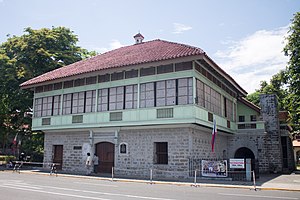This article has multiple issues. Please help improve it or discuss these issues on the talk page. (Learn how and when to remove these messages)
|

Báhay na bató (Filipino for "stone house"), also known in Visayan languages as baláy na bató or balay nga bato, and in Spanish language as Casa de Filipina is a type of building originating during the Spanish colonial period of the Philippines. It is an updated version of the traditional bahay kubo of the Christianized lowlanders, known for its use of masonry in its construction. It uses stone and brick materials, and later synthetic concrete, rather than just organic materials of the former style. Its design has evolved, but still maintains the bahay kubo's architectural principle, which is adapted to the tropical climate, stormy season, and earthquake-prone environment of the whole archipelago of the Philippines. It fuses bahay kubo's archetecture with the influence of Spanish colonizers. It is one of the many architecture styles throughout the Spanish Empire known as Arquitectura mestiza. The style is a hybrid of Austronesian and Spanish architecture; and later, with early 20th-century American architecture, supporting the fact that the Philippines is a result of these cultures mixing. Its most common appearance features an elevated, overhanging, wooden upper story (with balustrades, ventanillas, and capiz-shell sliding windows) standing on wooden posts suported by a rectangular foundation. The posts are placed behind Spanish-style solid stone blocks or bricks, giving the impression of a first floor. The ground level contains storage rooms, cellars, shops, or other business-related functions. The second floor contains the living areas as it is with the bahay kubo. The roof materials are either Spanish-style curving clay tiles (teja de curva)[1] or thatched with leaves (like nipa, sago palm, or cogon). Later 19th-century designs feature galvanization. Roof designs are traditionally high pitched and include gable, hip, or a traditional combination of both (similar to the East Asian hip-and-gable roof). Horses for carriages are housed in stables called caballerizas.
It was popular among the elite or middle-class and the 19th century was the high point of these houses’ construction, when wealthy Filipinos built them all over the archipelago.

The same architectural style was used for Spanish-era convents, monasteries, schools, hotels, factories, and hospitals, with some of the American-era Gabaldon school buildings, all with few adjustments. This style was still used during the American colonization of the Philippines. After the Second World War, construction of these buildings declined and eventually stopped in favor of post-World War II modern architecture.
Today, these houses are more commonly called ancestral houses, due to most ancestral homes in the Philippines being of bahay na bato architecture.
- ^ Martinez, Glenn. "Here's A Complete List Of The 46 Parts of A Filipino House". RealLiving. Retrieved September 2, 2024.
